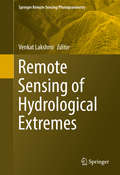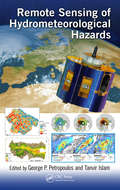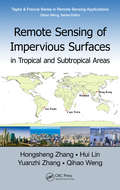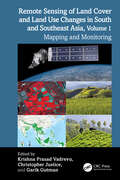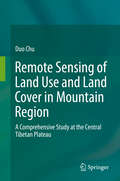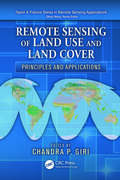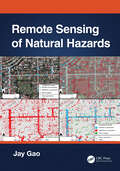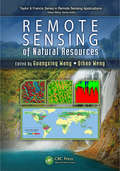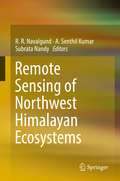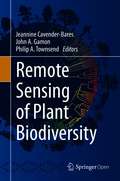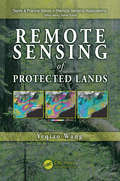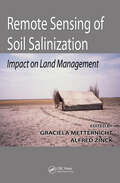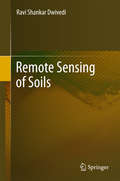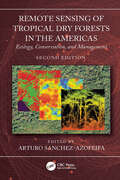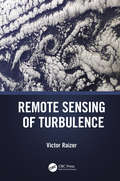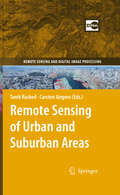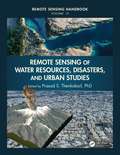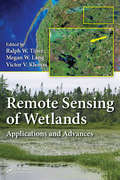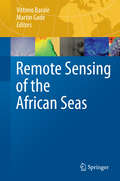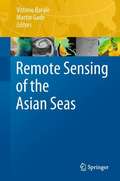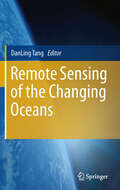- Table View
- List View
Remote Sensing of Global Croplands for Food Security (Remote Sensing Applications Series)
by Prasaii S. Thenkabail John G. Lvon Hulgh Tiirral Chanirashelhar M. BiraiaakIncreases in populations have created an increasing demand for food crops while increases in demand for biofuels have created an increase in demand for fuel crops. What has not increased is the amount of croplands and their productivity. These and many other factors such as decreasing water resources in a changing climate have created a crisis like
Remote Sensing of Hydrological Extremes
by Venkat LakshmiThis volume provides in-depth coverage of the latest in remote sensing of hydrological extremes: both floods and droughts. The book is divided into two distinct sections - floods and droughts - and offers a variety of techniques for monitoring each. With rapid advances in computer modelling and observing systems, floods and droughts are studied with greater precision today than ever before. Land surface models, especially over the entire Continental United States, can map the hydrological cycle at kilometre and sub-kilometre scales. In the case of smaller areas there is even higher spatial resolution and the only limiting factor is the resolution of input data. In-situ sensors are automated and the data is directly relayed to the world wide web for many hydrological variables such as precipitation, soil moisture, surface temperature and heat fluxes. In addition, satellite remote sensing has advanced to providing twice a day repeat observations at kilometre to ten-kilometre spatial scales. We are at a critical juncture in the study of hydrological extremes, and the GPM and SMAP missions as well as the MODIS and GRACE sensors give us more tools and data than were ever available before. A global variety of chapter authors provides wide-ranging perspectives and case studies that will make this book an indispensable resource for researchers, engineers, and even emergency management and insurance professionals who study and/or manage hydrological extremes.
Remote Sensing of Hydrometeorological Hazards
by Tanvir Islam George P. PetropoulosExtreme weather and climate change aggravate the frequency and magnitude of disasters. Facing atypical and more severe events, existing early warning and response systems become inadequate both in scale and scope. Earth Observation (EO) provides today information at global, regional and even basin scales related to agrometeorological hazards. This book focuses on drought, flood, frost, landslides, and storms/cyclones and covers different applications of EO data used from prediction to mapping damages as well as recovery for each category. It explains the added value of EO technology in comparison with conventional techniques applied today through many case studies.
Remote Sensing of Impervious Surfaces (Remote Sensing Applications Series)
by Qihao WengRemote sensing of impervious surfaces has matured using advances in geospatial technology so recent that its applications have received only sporadic coverage in remote sensing literature. Remote Sensing of Impervious Surfaces is the first to focus entirely on this developing field. It provides detailed coverage of mapping, data extraction,
Remote Sensing of Impervious Surfaces in Tropical and Subtropical Areas (Remote Sensing Applications Series)
by Qihao Weng Hongsheng Zhang Hui Lin Yuanzhi ZhangRemote Sensing of Impervious Surfaces in Tropical and Subtropical Areas offers a complete and thorough system for using optical and synthetic aperture radar (SAR) remote sensing data for improving impervious surface estimation (ISE). Highlighting tropical and subtropical areas where there is significant cloud occurrence and varying phenology, the b
Remote Sensing of Land Cover and Land Use Changes in South and Southeast Asia, Volume 1: Mapping and Monitoring
by Garik Gutman Krishna Prasad Vadrevu Christopher JusticeSouth and Southeast Asian countries are experiencing rapid land cover and land use changes (LCLUC) due to urbanization, agricultural expansion, deforestation, and infrastructure development. These changes have far-reaching consequences for biodiversity, water resources, food security, and climate regulation, underscoring the urgent need for effective monitoring and management strategies. Remote sensing data is essential for mapping and monitoring these changes. A variety of remote sensing data, ranging from coarse to very high resolution, can be used to assess land use patterns, and quantify changes.Volume 1 showcases the practical utility of remote sensing data in various LCLUC studies. The book features contributions from the NASA-funded South/Southeast Asia Research Initiative and collaborators from multiple countries in South and Southeast Asia.Key Features: Explores the latest methodologies, from deep learning to novel data integrations, for mapping LCLUC. Demonstrates case studies to monitor and map land cover changes using very-high, medium, and coarse-resolution satellite data. Highlights the role of remote sensing in integrating biophysical and socioeconomic data. Provides case studies on urban expansion, deforestation, and agricultural intensification. Demonstrates advanced remote sensing methods for tracking land use changes. Offers insights into sustainable land management using remote sensing and geospatial technologies. This book serves as a cornerstone for advancing research and collaboration in the field of remote sensing and land use studies, particularly in South and Southeast Asia. It will be an invaluable resource for mapping and monitoring professionals, including remote sensing experts, geographers, environmental scientists, ecologists, and all others involved in land use/cover change research.
Remote Sensing of Land Cover and Land Use Changes in South and Southeast Asia, Volume 2: Impacts on the Environment
by Garik Gutman Krishna Prasad Vadrevu Christopher JusticeSouth and Southeast Asian countries are experiencing rapid land cover and land use changes (LCLUC) driven by urbanization, agricultural expansion, deforestation, and infrastructure development. These transformations have significant impacts on biodiversity, water resources, food security, and climate regulation. There is an urgent need to quantify LCLUC impacts to design effective management strategies that help understand, mitigate, and adapt to these changes. Remote sensing data plays a crucial role in providing diverse information essential for assessing land use patterns, quantifying changes, and evaluating both environmental and societal impacts.Volume 2 explores the complex and dynamic interactions between land use and the environment in the region. It brings together expertise from U.S. contributors of the NASA-funded Southeast Asia Research Initiative (SARI) and collaborators from South and Southeast Asian countries.Key Features: Presents case studies on LCLUC impacts related to food security, heat stress, urbanization, agricultural intensification, water scarcity, forest transitions, and ecosystem health. Demonstrates the use of novel machine learning and deep learning algorithms for quantifying LCLUC impacts. Explores how satellite remote sensing can reveal hidden patterns, track environmental degradation, and support resource management. Highlights the integration of very high-resolution data with mid-resolution satellite data for effective LCLUC impact mapping and monitoring. Adopts a multidisciplinary approach, emphasizing the integration of biophysical and socio-economic data to address LCLUC impacts. This book highlights the transformative power of remote sensing and geospatial technologies while calling researchers, policymakers, and practitioners to action. It offers valuable insights for scientists, geographers, ecologists, remote sensing specialists, and anyone interested in the intersection of land use, development, and environmental sustainability.
Remote Sensing of Land Use and Land Cover in Mountain Region: A Comprehensive Study at the Central Tibetan Plateau
by Duo ChuThis book presents the spatial and temporal dynamics of land use and land cover in the central Tibetan Plateau during the last two decades, based on various types of satellite data, long-term field investigation and GIS techniques. Further, it demonstrates how remote sensing can be used to map and characterize land use, land cover and their dynamic processes in mountainous regions, and to monitor and model relevant biophysical parameters.The Tibetan Plateau, the highest and largest plateau on the Earth and well known as “the roof of the world,” is a huge mountainous area on the Eurasian continent and covers millions of square kilometers, with an average elevation of over 4000 m. After providing an overview of the background and an introduction to land use and land cover change, the book analyzes the current land use status, dynamic changes and spatial distribution patterns of different land-use types in the study area, using various types of remotely sensed data, digital elevation models and GIS spatial analysis methods to do so. In turn, it discusses the main driving forces, based on the main physical environment variables and socioeconomic data, and provides a future scenario analysis of land use change using a Markov chain model. Given its scope, it provides a valuable reference guide for researchers, scientists and graduate students working on environmental change in mountainous regions around the globe, and for practitioners working at government and non-government agencies.
Remote Sensing of Land Use and Land Cover: Principles and Applications (Remote Sensing Applications Series)
by Chandra P. GiriFilling the need for a comprehensive book that covers both theory and application, Remote Sensing of Land Use and Land Cover: Principles and Applications provides a synopsis of how remote sensing can be used for land-cover characterization, mapping, and monitoring from the local to the global scale. With contributions by leading scientists from aro
Remote Sensing of Natural Hazards
by Jay GaoThis book presents a comprehensive coverage of remote sensing technology used to gather information on 12 types of natural hazards in the terrestrial sphere, biosphere, hydrosphere, and atmosphere. It clarifies in detail how to yield spatial and quantitative data on a natural hazard, including its spatial distribution, severity, causes, and the likelihood of occurrence. The author explains multiple methods of attaining data, describes the pros and cons of each method, and encourages readers to choose the best method applicable to their case. The author offers a practical approach to data analysis using the most appropriate methods and software. 1. Covers all major natural hazards including hurricanes, tornadoes, wildfires, and avalanches. 2. Studies each natural hazard holistically, ranging from spatial extent, severity, impact assessment, causes, and prediction of occurrence. 3. Explains different remotely sensed data and the most appropriate method used. 4. Compares different ways of sensing and clarifies the pros and cons of any selected data or their analysis. 5. Provides ample examples of each aspect of a natural hazard studied augmented with graphic illustrations and quality assurance information. All professionals working in the field of natural hazards, senior undergraduate, and graduate students, will find in-depth approaches and sufficient information to become knowledgeable in the methods of yielding and analyzing data provided with remote sensing technology, ultimately providing a deeper understanding of natural hazards.
Remote Sensing of Natural Resources (Remote Sensing Applications Series)
by Qihao Weng Guangxing WangHighlighting new technologies, Remote Sensing of Natural Resources explores advanced remote sensing systems and algorithms for image processing, enhancement, feature extraction, data fusion, image classification, image-based modeling, image-based sampling design, map accuracy assessment and quality control. It also discusses their applications for
Remote Sensing of Northwest Himalayan Ecosystems
by R. R. Navalgund A. Senthil Kumar Subrata NandyHimalaya, one of the global biodiversity hotspots, is the abode of a variety of flora and fauna. The Himalayan ecosystems have immense ecological, socioeconomic, and aesthetic significance as they provide a wide range of ecosystem services. The northwest Himalaya (NWH), covering three states of India viz., Uttarakhand, Himachal Pradesh, and Jammu and Kashmir, starts from the foothills of Shivaliks in the south and extends to the greater Himalaya in the north. This region is also the source of some of the major rivers of India. With the increase in population, the NWH ecosystems have been under threat due to deforestation, loss of biodiversity, expansion of agriculture and settlement, overexploitation of natural resources, habitat loss and fragmentation, poaching, mining, construction of roads and large dams, and unplanned tourism. The Himalaya being young and geotectonically active, remains inherently unstable, fragile, and prone to natural disasters. Climate change is also likely to impact the Himalayan cryosphere drastically. Recognizing the importance of the Himalaya, a National Mission for Sustaining the Himalayan Ecosystem, one of the eight missions under the National Action Plan on Climate Change (NAPCC) of Govt. of India, to conserve biodiversity, forest cover and other ecological values in the Himalayan region has been taken up.Spaceborne remote sensing with its ability to provide synoptic and repetitive coverage has emerged as a powerful tool for assessment and monitoring of the Himalayan resources and phenomena. Indian Institute of Remote Sensing, Dehradun has taken up a number of studies in the fields of geology, water resources, forestry, agriculture, urban settlement, etc., over the last decade. The book summarises the work carried out in different disciplines, illustrated with tables and figures and a host of relevant references. It is hoped that the book serves as an excellent reference of immense value to the students, researchers, professors, scientists, professionals, and decision makers working in the NWH region.
Remote Sensing of Plant Biodiversity
by Jeannine Cavender-Bares John A. Gamon Philip A. TownsendThis Open Access volume aims to methodologically improve our understanding of biodiversity by linking disciplines that incorporate remote sensing, and uniting data and perspectives in the fields of biology, landscape ecology, and geography. The book provides a framework for how biodiversity can be detected and evaluated—focusing particularly on plants—using proximal and remotely sensed hyperspectral data and other tools such as LiDAR. The volume, whose chapters bring together a large cross-section of the biodiversity community engaged in these methods, attempts to establish a common language across disciplines for understanding and implementing remote sensing of biodiversity across scales. The first part of the book offers a potential basis for remote detection of biodiversity. An overview of the nature of biodiversity is described, along with ways for determining traits of plant biodiversity through spectral analyses across spatial scales and linking spectral data to the tree of life. The second part details what can be detected spectrally and remotely. Specific instrumentation and technologies are described, as well as the technical challenges of detection and data synthesis, collection and processing. The third part discusses spatial resolution and integration across scales and ends with a vision for developing a global biodiversity monitoring system. Topics include spectral and functional variation across habitats and biomes, biodiversity variables for global scale assessment, and the prospects and pitfalls in remote sensing of biodiversity at the global scale.
Remote Sensing of Protected Lands (Remote Sensing Applications Series)
by Yeqiao WangNational parks, wildlife refuges and sanctuaries, natural reserves, conservation areas, frontier lands, and marine-protected areas are increasingly recognized as essential providers of ecosystem services and biological resources. As debates about climate change and sustainability intensify, protected areas become more important as indicators of eco
Remote Sensing of Soil Salinization: Impact on Land Management
by Graciela Metternicht J. Alfred ZinckRecognized and advocated as a powerful tool, the role of remote sensing in identifying, mapping, and monitoring soil salinity and salinization will continue to expand. Remote Sensing of Soil Salinization: Impact on Land Management delineates how to combine science and geospatial technologies for smart environmental management. Choose the Right Tech
Remote Sensing of Soils
by Dwivedi Ravi ShankarThis book is about applications of remote sensing techniques in the studies on soils. In pursuance of the objective, the book initially provides an introduction to various elements and concepts of remote sensing, and associated technologies , namely Geographic Information System (GIS), Global Positioning System (GPS) in chapter-1. An overview of the sensors used to collect remote sensing data and important Earth observation missions is provided in chapter-2. The processing of satellite digital data (geometric and radiometric corrections, feature reduction, digital data fusion, image enhancements and analysis) is dealt with in Chapter-3. In the chapter to follow the interpretation of remote sensing data , very important and crucial step in deriving information on natural resources including soils resources, is discussed. An introduction to soils as a natural body with respect to their formation, physical and chemical properties used during inventory of soils, and soil classification is given in Chapter-5. The spectral response patterns of soils including hyperspectral characteristics -fundamental to deriving information on soils from spectral measurements, and the techniques of soil resources mapping are discussed in chapter-6 and -7,respectively. Furthermore, the creation of digital soil resources database and the development of soil information systems, a very important aspect of storage and dissemination of digital soil data to the end users are discussed in ch. apter-8. Lastly, the applications of remote sensing techniques in soil moisture estimation and soil fertility evaluation are covered in chapter-9 and -10, respectively.
Remote Sensing of Tropical Dry Forests in the Americas: Ecology, Conservation, and Management
by Arturo Sanchez-AzofeifaThis second edition focuses on Tropical Dry Forests (TDF) in the Americas and provides a comprehensive overview of new studies conducted in the last decade, giving new insights into the most endangered ecosystem in the tropics. Written by experts in remote sensing, ecosystem services, and ecology, the book concentrates on four thematic areas such as LiDAR remote sensing, remote sensing and ecology, quantification of ecosystem services, and TDF ecology. The case studies presented in this edition provide information on how emerging technologies can be applied to analyze biophysical properties and the status of TDFs across different regions in Mexico, Costa Rica, Brazil, and Bolivia.Features Includes all new content and does not replace the previous edition. Offers insight into the application of airborne and terrestrial laser scanning in tropical dry forests. Discusses ecology, remote sensing, hydrological modelling and ecosystem services. Includes novel information to build additional comparisons with peer-reviewed datasets. Highlights scientific achievements from different countries with tropical dry forests. Enables readers to comprehend and apply further comparative studies within the same ecosystem. This is an excellent book for professionals, academics, and students in the fields of Remote Sensing, Hydrology, and Environmental Science, as well as for Geographers, Ecologists, and individuals involved in the management of tropical dry forests.
Remote Sensing of Turbulence
by Victor RaizerThis book offers a unique multidisciplinary integration of the physics of turbulence and remote sensing technology. Remote Sensing of Turbulence provides a new vision on the research of turbulence and summarizes the current and future challenges of monitoring turbulence remotely. The book emphasizes sophisticated geophysical applications, detection, and recognition of complex turbulent flows in oceans and the atmosphere. Through several techniques based on microwave and optical/IR observations, the text explores the technological capabilities and tools for the detection of turbulence, their signatures, and variability. FEATURES Covers the fundamental aspects of turbulence problems with a broad geophysical scope for a wide audience of readers Provides a complete description of remote-sensing capabilities for observing turbulence in the earth’s environment Establishes the state-of-the-art remote-sensing techniques and methods of data analysis for turbulence detection Investigates and evaluates turbulence detection signatures, their properties, and variability Provides cutting-edge remote-sensing applications for space-based monitoring and forecasts of turbulence in oceans and the atmosphere This book is a great resource for applied physicists, the professional remote sensing community, ecologists, geophysicists, and earth scientists.
Remote Sensing of Urban and Suburban Areas
by Carsten Jürgens Tarek Rashed"Remote Sensing of Urban and Suburban Areas" provides instructors with a text reference that has a logical and easy-to-follow flow of topics around which they can structure the syllabi of their urban remote sensing courses. Topics have been chosen to bridge the gap between remote sensing and urban studies through a better understanding of the science that underlies both fields. In so doing, the book includes 17 chapters written by leading international experts in respected fields to provide a balanced coverage of fundamental issues in both remote sensing and urban studies. Emphasis is placed on: theoretical and practical issues in contemporary urban studies and remote sensing; the spectral, spatial and temporal requirements of remotely sensed data in relation to various urban phenomena; methods and techniques for analyzing and integrating remotely sensed data and image processing with geographic information systems to address urban problems; and examples of applications in which applying remote sensing to tackle urban problems is deemed useful and important.
Remote Sensing of Water Resources, Disasters, and Urban Studies: Remote Sensing Of Water Resources, Disasters, And Urban Studies (Remote Sensing Handbook)
by Prasad S. ThenkabailThis book is the most comprehensive documentation of the scientific and methodological advances that have taken place in understanding remote sensing data, methods, and applications over last 50 years. In a very practical way it demonstrates the experience, utility, methods and models used in studying a wide array of water applications. There are more than 100 leading global experts in the field contributing to this work.
Remote Sensing of Wetlands: Applications and Advances
by Victor V. Klemas Ralph W. Tiner Megan W. LangEffectively Manage Wetland Resources Using the Best Available Remote Sensing TechniquesUtilizing top scientists in the wetland classification and mapping field, Remote Sensing of Wetlands: Applications and Advances covers the rapidly changing landscape of wetlands and describes the latest advances in remote sensing that have taken place over the pa
Remote Sensing of the African Seas
by Vittorio Barale Martin GadeThe African Seas include marginal basins of two major oceans, the Atlantic and the Indian, a miniature ocean, the Mediterranean Sea, and an infant ocean, the Red Sea. Understanding the wide spectrum of environmental features and processes of such a varied collection of marine and coastal regions requires that in situ observation systems be integrated and actually guided, by the application of orbital remote sensing techniques. This volume reviews the current potential of Earth Observations to help in the exploration of the marginal seas around Africa, by virtue of both passive and active techniques, working in several spectral ranges - i. e. measuring either reflected visible and near-infrared sunlight, as well as surface emissions in the thermal infrared and microwave spectral regions, or again the surface reflection of transmitted lidar or radar impulses of visible or microwave radiation. The in-depth evaluation of the advantages offered by each technique and spectral region and in particular by the development of advanced multi-technique systems, contributes to the assessment of the abundant natural resources that the Seas of Africa have to offer, of those in dear need of being - sustainably - exploited and of others that should be protected and maintained in their still pristine conditions.
Remote Sensing of the Asian Seas
by Vittorio Barale Martin GadeA wide variety of marginal basins, ranging from polar to equatorial regions, and a few sizeable enclosed basins, can all be included among the Asian Seas. The Arctic Ocean shelf seas off Siberia; the sheltered basins along the Pacific Ocean’s western rim; the coastal seas of the northernmost Indian Ocean, including the semi-enclosed Red Sea and Persian Gulf; the Caspian Sea, the remnants of the Aral Sea and a score of brackish or freshwater lakes, such as Lake Balkhash and Lake Baykal; all exhibit a multiplicity of environmental features and processes. Understanding the peculiarities of such a large and varied collection of marine and coastal types requires integrated observation systems, among which orbital remote sensing must play an essential role. This volume reviews the current potential of Earth Observations in assessing the many Asian seascapes, using both passive and active techniques in diverse spectral regions, such as measuring reflected visible and near-infrared sunlight and surface emissions in the thermal infrared and microwave range, or surface reflection of transmitted radar pulses in the microwave range. An in-depth evaluation of the available spectral regions and observation techniques, as well as of novel multi-technique methods, ensures that suitable tools are indeed accessible for exploring and managing the wealth of resources that the Asian Seas have to offer.
Remote Sensing of the Changing Oceans
by Danling TangRemote Sensing of the Changing Oceans is a comprehensive account of the basic concepts, theories, methods and applications used in ocean satellite remote sensing. The book provides a synthesis of various new ideas and theories and discusses a series of key research topics in oceanic manifestation of global changes as viewed from space. A variety of research methods used in the analysis and modeling of global changes are introduced in detail along with numerous examples from around the world's oceans. The authors review the changing oceans at different levels, including Global and Regional Observations, Natural Hazards, Coastal Environment and related scientific issues, all from the unique perspective of Satellite Observation Systems. Thus, the book not only introduces the basics of the changing oceans, but also new developments in satellite remote sensing technology and international cooperation in this emerging field. Danling Tang (Lingzis) received her Ph.D from Hong Kong University of Science and Technology. She conducted research and teaching in Hong Kong, USA, Japan, and South Korea for more than 10 years; in 2004, she received "100 Talents Program of Chinese Academy of Sciences" and returned to China. She was a professor of Fudan University, and now is a Leading Professor of "Remote Sensing of Marine Ecology and Environment" at the South China Sea Institute of Oceanology, Chinese Academy of Sciences. Dr. Tang has been working on satellite remote sensing of marine ecology and environment; her major research interests include ocean dynamics of phytoplankton bloom, global environmental changes, and natural hazards. Dr. Tang has organized several international conferences, workshops, and training, she also services as member of organizing committee for several international scientific organizations; she was the Chairman of the 9th Pan Ocean Remote Sensing Conference (PORSEC 2008), and currently is the President-elect of PORSEC Association.
Remote Sensing of the Cryosphere (The Cryosphere Science Series)
by Marco TedescoThe cryosphere, that region of the world where water is temporarily or permanently frozen, plays a crucial role on our planet. Recent developments in remote sensing techniques, and the acquisition of new data sets, have resulted in significant advances in our understanding of all components of the cryosphere and its processes. This book, based on contributions from 40 leading experts, offers a comprehensive and authoritative overview of the methods, techniques and recent advances in applications of remote sensing of the cryosphere. Examples of the topics covered include: • snow extent, depth, grain-size and impurities • surface and subsurface melting • glaciers • accumulation over the Greenland and Antarctica ice sheets • ice thickness and velocities • gravimetric measurements from space • sea, lake and river ice • frozen ground and permafrost • fieldwork activities • recent and future cryosphere-oriented missions and experiments All figures are in color and provide an excellent visual accompaniment to the technical and scientific aspect of the book. Readership: Senior undergraduates, Masters and PhD Students, PostDocs and Researchers in cryosphere science and remote sensing. Remote Sensing of the Cryosphere is the significant first volume in the new Cryosphere Science Series. This new series comprises volumes that are at the cutting edge of new research, or provide focussed interdisciplinary reviews of key aspects of the science.

